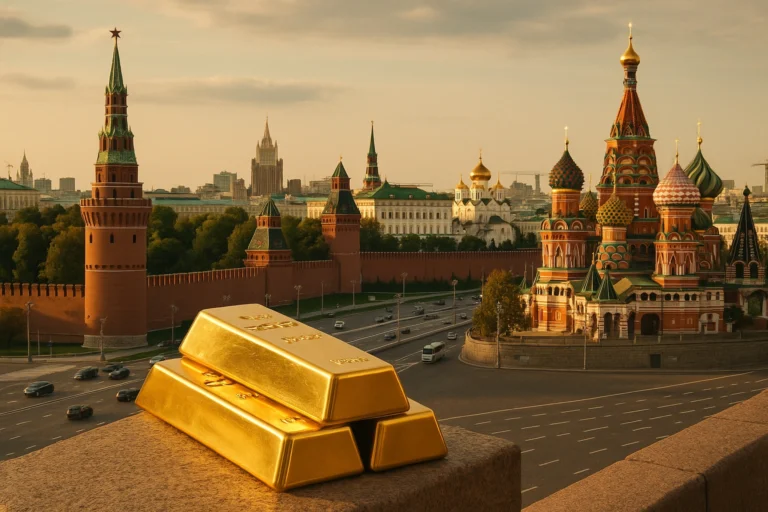
Central bank’s experimental plan restricts crypto trading to a small circle of high-net-worth investors, marking a cautious step into digital assets.
Could Russia’s latest financial experiment signal a cautious embrace of cryptocurrencies? In a move blending tight controls with innovation, Russia is launching a limited foray into crypto investments. The country’s central bank has outlined a proposal that would allow only the wealthiest and most qualified investors to trade digital currencies under a closely watched pilot program. This step comes as Moscow balances the lure of crypto markets with ongoing wariness of their risks and geopolitical calculations.
Key Developments
Russia’s central bank has submitted a proposal to establish a three-year Experimental Legal Regime (EPR) for cryptocurrency investments. The framework – developed under President Vladimir Putin’s directive – would authorize a “limited circle” of Russian investors to buy and sell cryptocurrencies like Bitcoin within the trial period. According to the plan, eligibility is strictly confined to “particularly qualified” investors. Individuals must hold over 100 million rubles (≈$1.1 million) in securities and deposits or earn more than 50 million rubles annually to participate. Additionally, corporate qualified investors and regulated financial organizations would be allowed into the experiment, subject to specific risk-based requirements imposed by the central bank.
If approved, the EPR will act as a regulated sandbox for crypto trading. The goal is to enhance market transparency, set service standards, and expand investment options for experienced investors in Russia. Within this framework, participants could trade digital assets under oversight, while non-deliverable instruments like cash-settled crypto derivatives and securities linked to crypto values are also on the table. Notably, the central bank is maintaining a hard line on general crypto use: cryptocurrency will not be recognized as legal tender, and outside the confines of this experiment, crypto transactions between residents would remain illegal, with penalties proposed for any violations. In other words, Bitcoin and its peers still can’t be used for day-to-day payments inside Russia – this initiative is strictly about controlled investments rather than broad circulation of crypto in the economy.
Political Impact
This cautious opening to crypto aligns with Russia’s broader financial strategy amid international pressures. For years, the Kremlin’s stance on digital currencies has been double-edged. Domestically, officials enforced a ban on using cryptocurrency for payments in 2021, reflecting deep skepticism of private digital money. Yet internationally, Western sanctions stemming from the Ukraine conflict have pushed Moscow to explore alternatives. In 2024, Russia legalized the use of cryptocurrencies for foreign trade transactions to bypass U.S. and EU sanctions, according to Finance Minister Anton Siluanov. Russian companies have since begun using Bitcoin and other digital currencies in cross-border deals – an effort to work around banks wary of Western scrutiny. Siluanov noted that Russian-mined bitcoins were already being used in export settlements and predicted such transactions would expand, calling international crypto payments a part of the future.
President Putin’s own comments underscore the geopolitical calculus. He has accused the U.S. of undermining its dollar by weaponizing it politically and suggested that countries will seek alternative assets outside Washington’s control. In this context, Bitcoin was singled out by Putin as an example of an asset beyond any single government’s reach. The new crypto investment regime fits into that narrative: it carefully opens a channel for digital assets, potentially strengthening Russia’s financial autonomy. By tightly limiting participation, the Kremlin can signal openness to innovation while mitigating regulatory and security concerns. The central bank continues to emphasize crypto’s inherent challenges – volatility, lack of state backing, and use in illicit activities – which long fueled its reluctance. The EPR structure is a political compromise between outright prohibition and laissez-faire adoption, allowing authorities to study crypto’s economic effects under controlled conditions.
Importantly, this move also comes as Russia promotes its central bank digital currency (Digital Ruble) and seeks to modernize its financial system without ceding control. The contrast between embracing a state-controlled digital ruble and tightly restricting decentralized cryptos highlights the regulatory tightrope Moscow is walking. Regulatory challenges remain – from establishing clear oversight for the EPR to ensuring participants don’t use crypto to circumvent laws outside the sandbox. The proposal’s success will depend on strict enforcement (with penalties as outlined) and coordination among Russian regulators, who have sometimes clashed on crypto policy. By pursuing this experiment, Russia is attempting to harmonize its internal cautious stance with the external reality that crypto is becoming an unavoidable part of global finance.
Economic Impact
Economically, the implications of Russia’s crypto trial are significant despite its limited scope. By opening the door to high-net-worth investors, the central bank could inject new liquidity and interest into both the Russian cryptocurrency market and traditional financial institutions. Large domestic banks and investment firms may develop new custodial services and products to facilitate crypto trading for their elite clients. Financial institutions that choose to participate will be subject to strict risk-weighted rules to contain any threats to the broader financial system. This means banks and asset managers could treat crypto similarly to high-risk assets, with higher capital requirements or limits on exposure, ensuring that a Bitcoin bust won’t imperil a major bank.
For Russia’s wealthy investors and corporations, the experiment offers a legal avenue to diversify into digital assets. Until now, any Russian individual wanting to invest in crypto faced legal gray areas or had to move funds abroad. With the EPR, a domestic framework for crypto investing could repatriate some of that capital into Russian oversight. Some analysts even speculate that the program paves the way for a “Russian MicroStrategy” – a reference to the U.S. company known for its massive Bitcoin treasury holdings. By allowing eligible firms to put Bitcoin on their balance sheets, Russia could soon see one of its major companies or banks emulate Michael Saylor’s crypto-heavy investment strategy. If a big energy giant or state-run corporation were to allocate a portion of its reserves to Bitcoin, it would signal a remarkable shift in corporate finance norms and potentially buoy crypto markets. In fact, a number of prominent global companies – from Elon Musk’s Tesla to fintech firms in Brazil and Japan – have already added Bitcoin to their holdings in recent years. A move by any of Russia’s top firms would put the country on that growing list and might inspire similar action in other emerging economies.
However, the economic impact will likely be restrained by design. Only a sliver of the population (those meeting the steep wealth criteria) can participate, so this is not a mass-market adoption of crypto. Everyday retail investors remain excluded, which limits potential consumer risks but also keeps crypto from becoming a widespread asset class in Russia for now. The immediate effect on global crypto prices is expected to be modest; analysts note that while Russia is opening a door, it’s doing so narrowly and cautiously. Still, the trial could stimulate Russia’s fintech sector – exchanges, brokers, and tech developers – to build infrastructure for compliant crypto trading. We might see partnerships or new ventures by Moscow-based financial institutions to handle crypto assets securely, from custody solutions to blockchain analytics, all under the central bank’s watch.
There’s also an eye on the interaction with foreign markets. If Russia’s richest are allowed to invest in crypto, some of that money could flow to international exchanges or ventures (assuming the rules permit using foreign platforms or custody). On the flip side, foreign crypto firms might have an opportunity to tap a segment of Russian demand through joint ventures or technology sharing, albeit under strict regulatory conditions. Investor protection and risk awareness will be key themes: the central bank has repeatedly warned that crypto prices can crash and that participants should be prepared to lose their entire investment. By limiting exposure to those who can ostensibly afford the risks, regulators aim to prevent a destabilizing impact on Russia’s overall economy. In summary, the economic impact ranges from new opportunities for professional investors and institutions, to cautious optimism among crypto businesses, tempered by the recognition that this is a tightly controlled experiment rather than a free-for-all boom.
Quick Insights
- Elite Investors Only: Under the proposal, only ultra-wealthy individuals (>$1.1 million in investments) or firms qualify to directly trade cryptocurrencies, excluding the general public. This creates a closed club of crypto investors in Russia, at least for the three-year trial period.
- 3-Year Regulatory Sandbox: The plan establishes a three-year sandbox (Experimental Legal Regime) where authorities will closely monitor crypto trading. It aims to boost market transparency and develop standard rules for digital asset transactions. Regulators intend to learn from this trial before considering any wider legalization.
- Crypto Still Not Currency: Bitcoin won’t be buying coffee in Moscow anytime soon. Russia will continue banning cryptocurrency as a form of payment in everyday transactions. Even within the experiment, crypto is treated as an investment asset, not legal tender. Any crypto deals between residents outside the approved framework would be illegal and penalized.
- Sanctions and Strategy: Geopolitics loom large. The move comes as Russia seeks financial resilience under Western sanctions, using crypto in international trade to skirt dollar restrictions. By cautiously embracing crypto assets at home, Moscow is testing whether it can harness global crypto markets without jeopardizing domestic financial stability or inviting new risks.
- Institutional Impact: Major Russian banks, funds, and corporations could be early adopters within this regime, potentially treating Bitcoin like a new asset class. The experiment could pave the way for a Russian equivalent of companies that hold significant crypto (a “Russian MicroStrategy” scenario) if any blue-chip firms decide to accumulate Bitcoin under state-sanctioned rules.
What’s Next?
The central bank’s crypto proposal now goes to the government and legislature for discussion and approval. Given President Putin’s backing, the plan stands a strong chance of moving forward. If greenlit, the experimental regime could launch later this year, kicking off a closely watched three-year trial. Regulators will need to set up the practical infrastructure: Which exchanges or platforms will be authorized? How will reporting and tax work? These details will likely emerge as the government crafts enabling legislation. The Bank of Russia will oversee the experiment, collecting data on trading volumes, investor behavior, and any emergent risks.
Outcomes of this trial could shape the future of crypto regulation in Russia. A successful experiment – with no major incidents and demonstrable economic benefits – might encourage lawmakers to expand access to crypto investment or make the framework permanent after 2028. We could see the eligibility thresholds lowered over time to admit more investors, or additional licensed exchanges opening to serve a growing market. There’s even a possibility that certain cryptocurrencies or tokens get more formally recognized as financial instruments if they prove their value under scrutiny. On the other hand, if the trial backfires – say a significant fraud occurs, or crypto volatility burns even these wealthy investors badly – the central bank would likely double down on its cautious stance, potentially tightening rules further or extending the experiment indefinitely. The risk of capital flight or misuse of crypto is also on the radar; authorities will be watching to ensure this channel isn’t used to illegally move funds abroad or evade taxes, which could invite a crackdown.
Globally, Russia’s move will be watched as a test case. Policymakers around the world are seeking the sweet spot between innovation and regulation in crypto markets. The European Union, for instance, is rolling out comprehensive MiCA regulations in 2024, integrating crypto into the mainstream financial regulatory framework. The United States debates over crypto rules and enforcement actions are ongoing, and China has maintained an outright ban on crypto trading. Russia is charting a middle path: not full prohibition, but not open doors either – rather a controlled experiment. If it works, it might offer a model for other emerging economies: embrace the new asset class, but start with the deep-pocketed investors first to contain potential fallout. This incremental approach could influence peers facing similar dilemmas of capital control versus market innovation.
One immediate question is how international regulators will respond. Western authorities have already targeted Russia-linked crypto activity as part of sanction enforcement – for example, the U.S. Treasury sanctioned crypto exchange Garantex for illicit finance ties. If Russia’s experiment leads to significant crypto flows, we might see closer scrutiny of those transactions on the global stage. Cooperation (or lack thereof) between Russian exchanges and international compliance standards (like anti-money laundering rules) will be a focal point. Future risks include the possibility of new U.S./EU sanctions specifically aimed at Russian crypto dealings or, conversely, new collaborations if Russia demonstrates a transparent system. Another development to watch is Russia’s own digital ruble project, which runs in parallel; how will a state-issued digital currency coexist with privately issued crypto in policy terms? The next few years will provide answers as Russia navigates these uncharted waters.
Regional Spotlight
This experimental crypto policy could have distinct regional and international reverberations. Within Russia, financial hubs like Moscow and St. Petersburg are poised to play a key role. These cities – home to the nation’s largest banks and stock exchanges – may host the infrastructure for the EPR, such as pilot crypto exchanges or authorized trading platforms. In fact, Russia has floated plans to establish two state-controlled crypto exchanges in Moscow and St. Petersburg focused on foreign trade transactions. Those plans, announced in 2024, aim to facilitate international deals in digital currencies, partly to mitigate sanction impacts. If they come to fruition alongside the new investment regime, Moscow and St. Petersburg could become twin centers of Russia’s crypto experiment: one outward-facing for cross-border commerce, and one inward-facing for domestic investors. Regional tech and finance talent in these cities might also benefit from new jobs and projects tied to crypto technology and compliance.
Beyond Russia’s borders, the move ties into the country’s engagement with the BRICS bloc (Brazil, Russia, India, China, South Africa) and other allies. BRICS nations have been vocal about reducing reliance on the U.S. dollar in mutual trade, exploring alternatives ranging from local currency settlements to even discussing a joint digital currency. President Putin used a BRICS summit in 2024 to champion the idea of using cryptocurrencies or a BRICS currency to protect trade from Western sanctions, though these ideas did not yet materialize into a formal plan. The official BRICS declaration encouraged using national currencies for trade but stopped short of endorsing crypto at a bloc level. Still, Russia’s domestic crypto trial could bolster its argument in future BRICS dialogues: Moscow can present itself as a testing ground for regulated crypto usage, with data and experience to share. If the experiment shows positive results, Russia might push BRICS partners to consider a cooperative approach to cryptocurrencies – perhaps through information exchange on regulation, or even laying groundwork for a BRICS-linked stablecoin (an idea that has been floated, tying a digital token to a basket of BRICS currencies). Such a stablecoin concept was hinted by Russian officials aiming to facilitate trade with partners like China, although significant technological and regulatory hurdles remain before that becomes reality.
It’s also noteworthy how this step might affect neighboring Eurasian Economic Union (EAEU) countries or other sanctioned states like Iran. If Russia demonstrates a viable model for crypto integration under sanctions, it could be replicated or adapted elsewhere. For example, Iran has also shown interest in using crypto to skirt sanctions and is watching these developments closely. On the flip side, allies with more open crypto markets (like Kazakhstan or the UAE, though not a Russian ally, but a friendly nation) might find new opportunities dealing with Russian crypto investors under the experimental regime. Regionally, the experiment underscores Russia’s intent to remain financially connected despite sanctions – be it through bilateral crypto arrangements or new payment corridors leveraging digital assets. In summary, while the crypto trial is domestic, its ripple effects could extend from Russia’s key cities to strategic partners across continents, all eager to see how digital currencies might recalibrate the balance of economic power.



